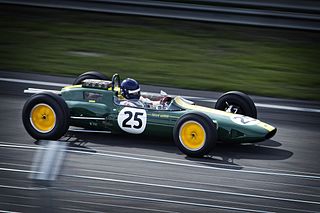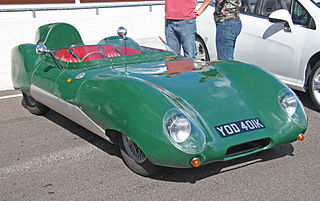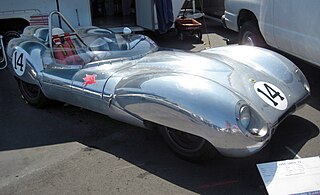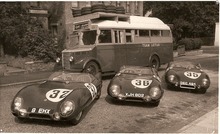
The Lotus Elite name has been used for two production vehicles and one concept vehicle developed and manufactured by British automobile manufacturer Lotus Cars. The first generation Elite Type 14 was produced from 1957 until 1963 and the second generation model from 1974 until 1982. The Elite name was also applied to a concept vehicle unveiled in 2010.

Vanwall was a motor racing team and racing car constructor that was active in Formula One during the 1950s. Founded by Tony Vandervell, the Vanwall name was derived by combining the name of the team owner with that of his Thinwall bearings produced at the Vandervell Products factory at Acton, London. Originally entering modified Ferraris in non-championship races, Vanwall constructed their first cars to race in the 1954 Formula One season. The team achieved their first race win in the 1957 British Grand Prix, with Stirling Moss and Tony Brooks sharing a VW 5, earning the team the distinction of constructing the first British-built car to win a World Championship race. Vanwall won the inaugural Constructors' Championship in Formula One in 1958, in the process allowing Moss and Brooks to finish second and third in the Drivers' Championship standings, each winning three races for Vanwall. Vandervell's failing health meant 1958 would be the last full season; the squad ran cars in a handful of races in the following years, but finished racing in 1961.

Coventry Climax was a British forklift truck, fire pump, racing, and other specialty engine manufacturer.

Singer Motors Limited was a British motor vehicle manufacturing business, originally a bicycle manufacturer founded as Singer & Co by George Singer, in 1874 in Coventry, England. Singer & Co's bicycle manufacture continued. From 1901 George Singer's Singer Motor Co made cars and commercial vehicles.

Nota Sports and Racing Cars is an automobile manufacturer in Australia. The company was founded by Guy Buckingham in 1952. He was an aircraft engineer and used his expertise to build triangulated spaceframed sportscars. Possibly Australia's first space-framed cars. In 1958 the company built a series of all-enveloping aluminium streamlined sports cars. First called "Streamliners", and later called "Mazengarbs". Up to 1960 eleven of those were made. In the late 1950s the company produced Formula Junior cars in both front and mid-engined formats. Nota also made a series of specialist monoposto racing cars for the track and hill climbing events. In 1963 the company made a series of Mini powered sports cars. In 1964 they started production of the Nota Sapphire, an alloy bodied sports and coupe designs with Ford Fiat and Coventry Climax engines. In 1965 Nota started producing Formula Vee cars for Warrick Farm race track making 34 in the first year. In the 1960s the company formulated their "Sportsman", a Lotus 7 lookalike, which they still build today and are now building in a mid-engined version for the modern day transverse engines which the major car manufacturers produce. In 1968 came the Nota Fang Chris Buckinghams first real design, a midengined sports car using a Cooper S engine power plant behind the driver but in front of the rear wheels, their most successful model with over 100 being made. Later the Fang was equipped with Lancia engines, then Toyota engines, finally being fitted with Toyota's V6 Quad cam supercharged engines with over 400BHP. In 1973 Nota started with their Marauder range of cars using the same mechanicals as the Nota Fang. At the same time they were making the Nota Levanti front engine twin cam coupe. In 1975 the supply of Leyland 1275 GT engines started to run out so Nota contacted FIAT and both Marauders and Fangs were made with the 2-litre twin cam FIAT/Lancia engine. Leyland were then approached and the P76 engine was fitted to the Marauders using a Nota made gearbox trans-axle with the gear box next to the driver and the engine behind. In the late 1970s Nota had started on 4WD 351 V8 mid-engined Marauders, but in the 1980s Ford stopped export of the 351 engine to Australia. After a trip to England Chris Buckingham assembled a design team to design a Fang with Fl 3 litre V6 quad cam engine as well as a fully enclosed, similarly specified Chimera. In 2003 Nota developed the Nota Le Mans, powered by either a Suzuki GTi 1300 cc or 1100 cc motor cycle engine. For road use it could also use a Toyota 1800 cc VVTi 6-speed or the 3.5-litre V6 quad cam. By 2012 Nota had decided that due to the lack of front engine rear wheel drive 4 cylinder engine being available they would use an existing front-engined Nota clubman chassis and move the seats forward by 150mm and fit a transverse engine behind the driver. It looks just like their front-engined clubmans but with the advantage of a mid-engined design.

The Lister Motor Company Ltd. is a British sports car manufacturer founded by Brian Lister in 1954 in Cambridge, England, which became known for its involvement in motorsport. After buying the company in 1986, Laurence Pearce produced variants of the Jaguar XJS before producing a bespoke sports car, the Lister Storm. In 2013, Lister Cars was acquired by Lawrence Whittaker's company Warrantywise. Production of the original sports car restarted in 2014 and ten continuation Lister Jaguar Knobblys were built to celebrate Lister's 60th Anniversary. In 2016, the company announced the build and sale of the Lister Knobbly Stirling Moss. On 31 January 2018, the Lister LFT-666 based on the Jaguar F-Type was announced.

Elva was a sports and racing car manufacturing company based in Bexhill, then Hastings and Rye, East Sussex, United Kingdom. The company was founded in 1955 by Frank G. Nichols. The name comes from the French phrase elle va.

The Lotus 17 was a sports car racing model built by Lotus Cars in 1959. Designed by Len Terry, it was built in response to the Lola Mk1 which was dominant against the previous Lotus model, the Eleven. It was replaced in 1960 by the Lotus 19.

The Lotus 25 was a racing car designed by Colin Chapman for the 1962 Formula One season. It was a revolutionary design, the first fully stressed monocoque chassis to appear in Formula One. In the hands of Jim Clark it took 14 World Championship Grand Prix wins and propelled him to his 1963 World Championship title. Its last World Championship win was at the 1965 French Grand Prix.

The Lotus Mark VI is the first production car by Lotus Cars. It was introduced by Colin Chapman in 1952 after previously building multiple trials and road racing cars. The heart of the Mark VI is a space frame chassis. Rather than a complete car, it was available to the general public as kit, wherein the customer could install any preferred engine and gearbox, making it eligible for a wider number of formulae.

The TVR Grantura is the first production model in a long line of TVR cars. It debuted in 1958 and went through a series of developments leading to the Mark I to Mark IV and 1800S models. The last ones were made in September 1967.

The 1957 24 Hours of Le Mans was the 25th running of the 24 Hours of Le Mans, Grand Prix of Endurance, and took place on 22 and 23 June 1957, on the Circuit de la Sarthe. It was also the fifth round of the F.I.A. World Sports Car Championship. Some 250,000 spectators had gathered for Europe's classic sports car race, around an 8.38-mile course. The prospect of an exciting duel between Ferrari, Maserati, Jaguar, Aston Martin and Porsche was enough to draw large crowds to the 24 Hours race, now back at its usual date and reintegrated into the World Championship.

The Lotus 18 was a race car designed by Colin Chapman for use by Lotus in Formula Junior, Formula Two, and Formula One.

The Westfield XI is a British sports car and kit car based on the Lotus Eleven.

The Lotus 23 was designed by Colin Chapman as a small-displacement sports racing car. Nominally a two-seater, it was purpose-built for FIA Group 4 racing in 1962–1963. Unlike its predecessors Lotus 15 and 17, the engine was mounted amidship behind the driver in the similar configuration developed on Lotus 19.

The Lotus Mark VIII car was Colin Chapman’s first fully enclosed aerodynamic design. Chapman's basic requirements for the design were for a car of 1100 lbs powered by an 85 bhp engine and a maximum speed of 125 mph. Work began on this design in late 1953 and Chapman was assisted in the design of the body by the aerodynamicist Frank Costin, who was the brother of Mike Costin, his main collaborator.

The Lotus Mark IX (1955) was an aluminium-bodied sports racing car manufactured by Lotus Engineering Ltd. About thirty of the Mark IX sports racing cars were made. It was closely related to the Lotus model Mark VIII (1954), of which only about seven cars were made. These cars were largely based on the innovative space frame of the Lotus Mark VI (1952). The highly aerodynamic bodies were designed by Frank Costin and constructed by Williams & Pritchard Limited.

The Lotus 15 is a front-engine sports racing car designed by Colin Chapman of Lotus, built from 1958 until 1960.

The Cooper T39, nicknamed the "Bob-Tail", is a successful lightweight, mid-engined, sports car, designed and developed by Owen Maddock at Cooper Cars, for sports car racing in 1955. The car debuted in active racing competition at the Easter race in Thruxton in 1955, being driven by Ivor Bueb, and was later entered into the 1955 24 Hours of Le Mans, being driven by John Brown and Edgar Wadsworth, but was unfortunately not classified, because even though the car managed to complete 207 laps around the 8.4-mile Le Mans circuit, it didn't manage to finish within 70% of the winners' race distance. However, between 1956 and 1962, it did manage to rack up and tally an incredible streak of domination and competitiveness, scoring 91 total wins and clinching 236 podiums finishes; an incredible record. It was powered by the 1,098 cc (67.0 cu in) Coventry-Climax four-cylinder engine.

The Abarth 207A Boano Spyder is a competition car created by Abarth & C. with the aim of selling in the United States market. It succeeded the earlier Abarth 205A Berlinetta and continued to use the Fiat 1100's four-cylinder engine. It also continued to use the naming practice started with the Cisitalia 202 and 204, which continued with the Abarth 204A and 205A. Design work started in 1954 and the car was first presented at the 1955 Turin Motor Show. A street-oriented version of the Spyder called the 208A, fitted with a panoramic windshield, was shown in 1954, as well as a Coupé model with an airy glasshouse, called the 209A. Both of the street versions appear to have remained one-offs.






















